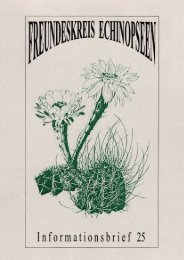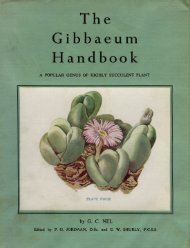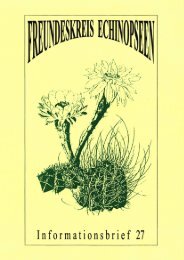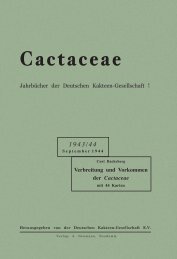journal
journal
journal
Create successful ePaper yourself
Turn your PDF publications into a flip-book with our unique Google optimized e-Paper software.
18 THE CACTUS AND SUCCULENT January, 1951<br />
ELECTRICITY IN THE GREENHOUSE<br />
By A. J. EDWARDS<br />
(A lecture at the monthly meeting, 10th October, 1950)<br />
In November, 1947 I spoke of the advantage of electric heating over other methods, such as boilers and pipes,<br />
oil heaters, etc. Since then I have had many enquiries about types of appliances, thermostats and soil heating.<br />
Firstly, i will deal with greenhouse heating and various types of appliances and their adaptation to the greenhouse,<br />
thermostatically controlled, to maintain a steady temperature. To attain this we must have sufficient appliances<br />
and a thermostat properly positioned for everything depends on their efficiency.<br />
Contrary to the common belief, the amount of current consumed does not depend on the size or number of<br />
heaters, for, when the apparatus is used in conjunction with a thermostat, they will switch on and off in accordance<br />
with the thermostat setting. Thermostats are switches operated by a bi-metal strip. The surrounding temperature<br />
causes the bi-metal strip to open or close. I have been asked why, with my thermostat set at a given figure, the<br />
temperature of the house falls three or four degrees below that of the setting. This is because of insufficient<br />
heaters to overcome the time lag with a quick failing temperature outside. You may calculate that you have the<br />
minimum amount of apparatus to maintain a certain temperature, but there is always time lag while the heat builds<br />
up, but once achieved it is maintained.<br />
Therefore, always have that extra amount of apparatus to overcome the time lag ; running cost will be no<br />
more. The apparatus will not be on for all the time as the thermostat cuts out the moment the air temperature<br />
is raised to the setting.<br />
The position of the thermostat is very important ; to give the best results, fix in a position not affected by<br />
draughts or hard against the glass where cold air radiating off the glass influences the thermostat instead of the<br />
general air of the house.<br />
The general effect of heating is that the tubes or panels, whichever are used, are mounted on the wall under<br />
the benches, and the air becoming warm, rises and forces the cold air down.<br />
With the thermostat in my greenhouse, I have fixed a one-inch thick wood panel over the glass and at a height<br />
of about eighteen inches to two feet above the level of the plants. This works satisfactorily and, with the thermostat<br />
set at forty degrees, the temperature has never fallen below that level.<br />
During observations of the last six winters, I have recorded, on a few occasions, a temperature outside of ten<br />
and twelve degrees of frost on a maximum and minimum thermometer fixed on a wooden post at a height of five<br />
feet, six inches from the ground level.<br />
Type of heaters : (I) round tubular heaters with a current consumption of sixty watts per foot ; (2) oval<br />
tubular heaters with a current consumption of eighty watts per foot ; (3) panel heaters with a current consumption<br />
of five hundred watts each ; (4) convector heaters with a current consumption of two to three thousand watts<br />
each ; (5) fan heaters with a current consumption of three thousand watts each. All are recommended to give<br />
satisfactory results, provided adequate apparatus is installed.<br />
Tubular and panel heaters are fixed on the wall just above floor level, on brackets, so as to give the maximum<br />
area of the tube or panel for the'air to pass round, hot air rises and cold air falls to the bottom and this process<br />
warms the air as it passes the heaters. Convectors stand on the floor or fixed against the wall and the same thing<br />
happens, but air passes through the convector. Fan heaters are heaters with a small fan which forces the air<br />
through the heater much quicker than by the method of convection and they reduce the time lag.<br />
Soil heating. This is becoming very popular in greenhouses and frames. If used in borders and built up beds<br />
on the staging, air temperature can be kept at a lower level as the equipment will keep up a steady soil temperature.<br />
Methods before soil heating raised air temperatures and the heat was conducted to the soil, resulting in a period<br />
of time before the soil temperature was raised to encourage root action, therefore, soil heating equipment gives<br />
a steady soil temperature, not too high an air temperature, the plants a more balanced atmosphere to live in. The
















